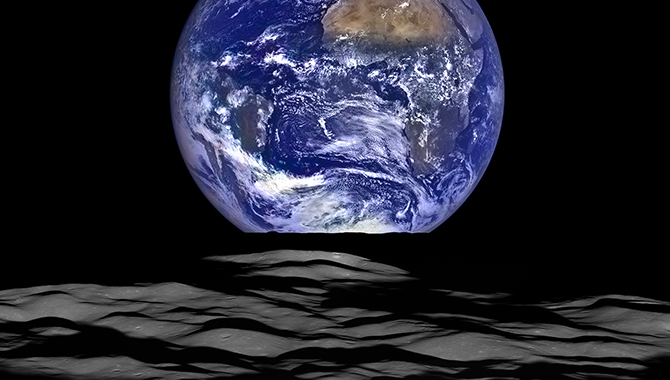
European Space Agency astronaut Luca Parmitano took this "space-selfie" during an extravehicular activity (EVA) at the International Space Station (ISS) in 2019. Six years earlier, Parmitano’s helmet dangerously filled with water during an EVA at the ISS.
Credit: NASA
High-visibility close call yields timeless lessons learned.
On July 16, 2013, Italian astronaut Luca Parmitano and NASA astronaut Chris Cassidy began a planned six-hour and fifteen-minute extravehicular activity (EVA) to connect a series of cables at the International Space Station. About 44 minutes into the EVA, Parmitano reported that there was “a lot of water” on the back of his head, inside his helmet. It was more than could be attributed to sweat this early into an EVA and came on the heels of a CO2 sensor failure in his spacesuit, minutes before.
By the time Parmitano was returning to the ISS airlock about 25 minutes later, there was between one and one-and-a-half liters of water in his helmet, covering his eyes, ears, and nose, and moving toward his mouth. “Just imagine walking around with your eyes closed in a fishbowl. Really, that’s what was going on at that… moment,” Parmitano would later say.
“By now, the upper part of the helmet is full of water and I can’t even be sure that the next time I breathe I will fill my lungs with air and not liquid,” Parmitano wrote of his struggle to return to the airlock in blog post on the European Space Agency’s website. Later, as the ISS crew was repressurizing the airlock, Parmitano contemplated his options, writing, “Now that we are repressurizing, I know that if the water does overwhelm me, I can always open the helmet. I’ll probably lose consciousness, but in any case, that would be better than drowning inside the helmet.”
EVA 23 was labeled as a high-visibility close call by NASA and examined by a Mishap Investigation Board (MIB) chaired by Chris Hansen, the Manager of the Extra Vehicular Activity Office at Johnson Space Center. Hansen presented Lessons Learned from the investigation at APPEL KS’s Project Knowledge Expo, earlier this year.
The ground teams weren’t aware of how serious the situation was until hours later, when Parmitano described what happened. Because water behaves differently in space, clinging to objects, much of the water in Parmitano’s helmet was stuck to his head and face. Parmitano’s measured reaction to the dangerous situation is credited with saving his life.
After the team realized how serious the incident was, the key question for investigators was “How could it have been prevented?”
The early focus during the EVA centered on a possible leak in the drink bag that astronauts wear on their chests, inside the suit. Previous designs had leaked before. Parmitano was instructed to drink the bag dry to eliminate it as a possible source. But the drink bag design Parmitano was wearing had never leaked and water continued to build in his helmet after the bag was dry.
The drink bag was also initially believed to be the source of about half a liter of water discovered in Parmitano’s suit after EVA 22. The water hadn’t interfered with the EVA. Parmitano first became aware of it when the airlock was pressurized. A misunderstanding led to the belief that Parmitano “didn’t drink at all” from the bag, which wasn’t full following EVA 22. He had actually said, of the water, he didn’t “drink it all.”
In fact, both drink bags were tested following EVA 23, and neither one leaked. Had that check been done after EVA 22, the high-visibility close call of EVA 23 might have been avoided.
The cause of the water in Parmitano’s helmet was complex and at least partially obscured because of the peculiar behavior of water in zero gravity. Contamination in the suit’s Fan Pump Separator clogged small holes in the device and blocked water from flowing properly. Instead, the water entered the suit’s air system and flowed into the helmet.
The same failure has occurred at Johnson Space Center, but gravity causes the water to pool inside the fan and stalls it. Had the fan stalled during EVA 23, it would have stopped pushing water toward Parmitano’s helmet. But in zero gravity, the water clung to the fan housing, worked its way around the fan, then travelled up.
During the investigation, NASA gathered a panel of talented engineers from varied backgrounds, which created a high degree of cognitive diversity. This quickly produced results. Panel members immediately began asking questions that pointed the investigation in the right direction.
The investigation identified three proximate causes, five root causes, and led to 49 recommendations, which NASA issued publicly in early 2014, leading to many significant changes.
Parmitano summed up his experience in the blog, “Space is a harsh, inhospitable frontier and we are explorers, not colonizers. The skills of our engineers and the technology surrounding us make things appear simple when they are not, and perhaps we forget this sometimes. Better not to forget.”
To learn more about EVA 23 and the other Project Knowledge Expo sessions, click here.









